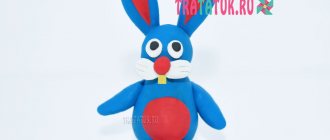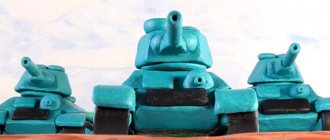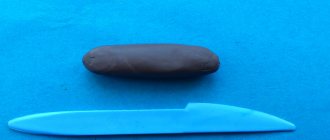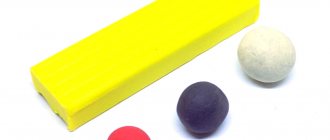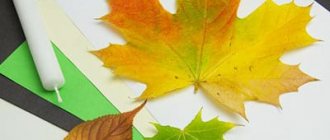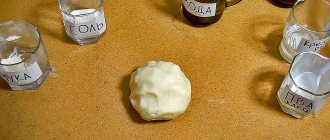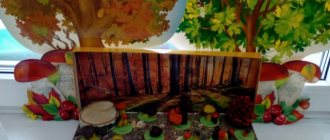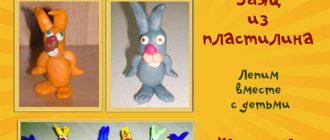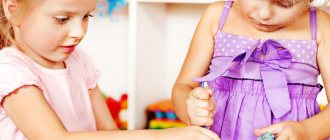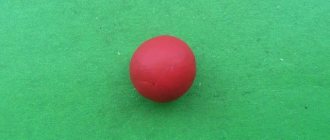MAGAZINE Preschooler.RF
Notes on modeling for children of the middle group “Dishes for dolls”Goal: Expand children's understanding of surrounding objects
Educational objectives:
- Strengthen children's ability to sculpt dishes.
- Practice sculpting techniques.
Developmental tasks:
- Activate vocabulary on the topic of tableware (sugar bowl, teapot, cups, saucers, thrush, spoons)
- Develop fine motor skills and eye.
Educational tasks:
- Arouse interest in teamwork to create a tea set for dolls.
- Foster activity, independence and accuracy in work.
Equipment. Doll dishes, bunny, plasticine, modeling board, stacks.
Preliminary work. Looking at tea sets at home, illustrations. D/I “Pick a Pair”
,
"What is missing"
.
Progress of the lesson.
1. Organizational moment.
The teacher leads the children to the group where the guests are sitting. Guys, look how many guests came to us! Let's say hello to them. (Children greet guests)
Children sit in a semicircle.
“Tea Party” by V. Shipunova
.
Like our Dunya’s cups and saucers, Like our Lyusenka’s little ones asking for tea:
- You are welcome - Come and visit. Come to visit. Come for some cookies
This is simply delicious - Visit the dolls on their birthday!
2. Game situation.
Educator. Guys, look who came to us? (Bunny)
A bunny came to us for help, he told me that the dolls and their friends want to have a party (a birthday, but they don’t have enough dishes. Let’s help the toys by making teaware for them.
Educator: Let's go with you to our workshop.
— Guys, look what’s on my table? (Tea-set)
There is a tea set on the table. Tell me what utensils are included in the tea set. (Children name: teapot, sugar bowl, cups, saucers, thrush; remind that all the items in the service are decorated the same way - polka dots, flowers, checkered patterns or something else. Children remember the tea sets they saw at home.
Comparison of dishes.
Educator: How are they different and similar: a plate and a saucer; cup and mug?
Game “Name what kind of dishes”
.
If the plate is made of plastic, then it is (what?)
-... If the spoon is made of metal, it is... If the cup is made of porcelain, it is... If the glass is made of glass, it...
If the sugar bowl is made of glass, then it... If the ladle is made of metal, it...
Physical education minute.
We begin exercises, standing in a circle, stretching our arms, jerking with our arms. Stretch your back and shoulders, turn right and left. To make it easier for us to sit.
Let's jump together, jump and jump! Jumping in place. Who will get the ceiling? Now walk in place. Walking. Let's all clap loudly together. Claps.
We quickly sat down at the tables and got down to business. Modeling cup and saucer.
Children make a plate out of a ball, flatten it and bend the edges a little, and decorate the plate with circles or stripes.
The cup is made from a ball, pressed a little into the middle, a handle is attached to the right. The cup can be made of any shape.
And before work, we will stretch our fingers.
Finger gymnastics “Knock-knock-knock”
.
Fingers came to visit,
Knock, knock, knock - they knocked on the door. Children tapping on the table
Only the door was not opened for them: with the pads of all fingers
They thought there was a terrible beast there. simultaneously.
The guys start working, they can implement any ideas. Offer to show the children some techniques for decorating tea cups, reciting all the actions ( “with a stripe”
— roll out a long flagellum and lay it along the rim - straight or in a wave).
Final part.
At the end of modeling, place all the works on the table and, together with the bunny, carefully examine them, draw the children’s attention to a more accurate representation of the shape of the dishes, to accuracy in work. Emphasize the variety of products and give them to dolls for their birthday.
| Next > |
Treat for the guest: summary of a modeling lesson in the middle group
Serovskaya O.A., Rybakova G.V., Evdokimova L.Yu. Treats for guests: summary of a modeling lesson in the middle group // Sovushka. 2019. N1 (15). URL: https://kssovushka.ru/zhurnal/15/ (access date: 02/05/2022).
Order No. 251575
Program content: continue to cultivate children's interest in modeling. Strengthen the ability to sculpt the shape of a disk, rhythmically decorate a rounded flat shape with rollers, apply a pattern in the form of stripes and dots in stacks. Teach children how to make challah by intertwining two or three sausages.
Material: plasticine or puff pastry, stacks, toys, doll plates, boards.
Progress of the lesson:
The doll table is covered with a tablecloth and served with doll dishes. There are various toys sitting at the table.
The teacher says: “Today, when I came to kindergarten, I accidentally heard our dolls talking. It turns out that their friends, the bunnies, are coming to visit them. All the residents of the play corner decided to prepare for the meeting of the guests and agreed on who could do what. The dogs swept the floor. The squirrels set the tables with tablecloths and napkins. The cats set out the dishes for tea. The dolls put on their most beautiful dresses, did their beautiful hairstyles - they are ready to meet the guests - the hares. But what should we treat them with? But then the bear remembered that bunnies love cookies, bagels and such beautiful braided buns that look like girls’ braids, but none of us know how to bake them.
Then everyone was upset, and the bear said: “Maybe the guys will make us such a treat, then the bunnies will be happy, and we’ll try them too.”
The teacher asks if the children want to start preparing a treat?
Having received their consent, he invites the children to first make a lot of different cookies and bagels. The teacher also invites the children to learn how to “bake” challah (similar to girls’ braids). Demonstration: divide a piece of dough or plasticine into three identical lumps, then roll them into three identical sausages. Having placed the sausages in a row on the board, we connect their upper ends, and then weave a braid. If weaving from three sausages is difficult for some children, instead of three sausages, they can make it from two.
During the work, the teacher helps by suggesting the sequence of actions.
When everyone has finished modeling, the teacher offers to help the dolls set the tables. Here the bunnies arrive on the train. The dolls meet them and invite everyone to sit down at the table, treating everyone to cookies, bagels, and challah. The teacher plays out the scene. The animals thank the children for the treats.
Description of crafts for children
Most kids today have a huge number of toys. It is useless to even try to describe what kind of heroes they belong to. Making a home for dolls and simulating real life is a common occurrence, in the implementation of which a large number of difficulties arise. For example, where to get dishes for your favorite characters. But the quality of the game itself and the child’s involvement in the process depend on this. We suggest making you such dishes from plasticine. This material is ideal as it allows you to make even the smallest parts. Although we will show you how to make a craft based on a teapot, once you have mastered the technique, you can move on. Subsequently, mugs, interior items and kitchen items may appear in your toy house.
The main thing is to understand how to work with small parts, and in what order you should always assemble the work. A teapot is a relatively simple figure if you know the order in which to perform the steps. In this case, we took special care of you and took a large number of clear photographs that are present in every action. Don't worry if something doesn't work out right away. After all, this is the essence of learning. Just carefully remove the part using a plastic knife and try again. After some time, you will notice that the craft will come to an end. In this case, our website also contains a huge number of works of varying levels of complexity.
